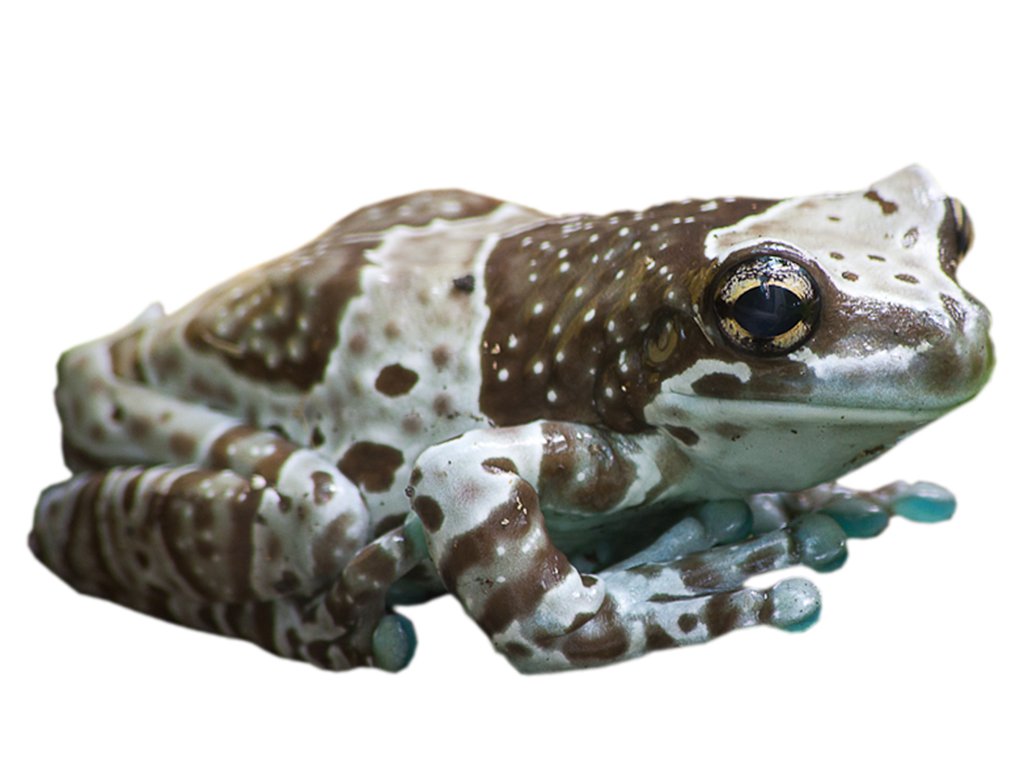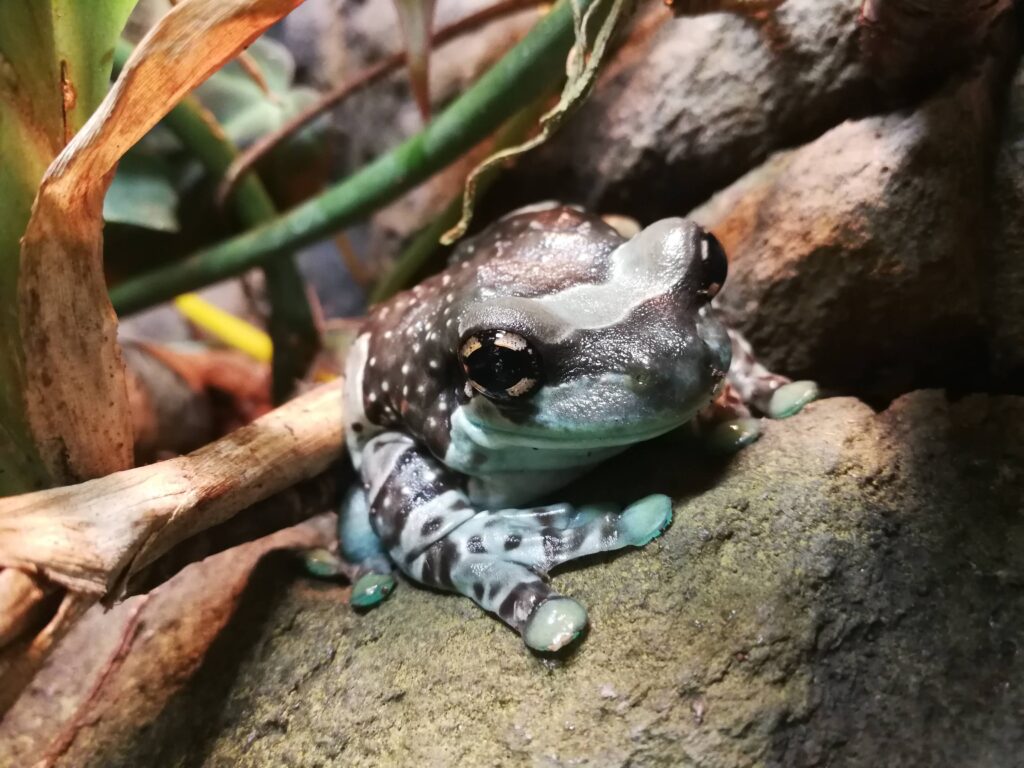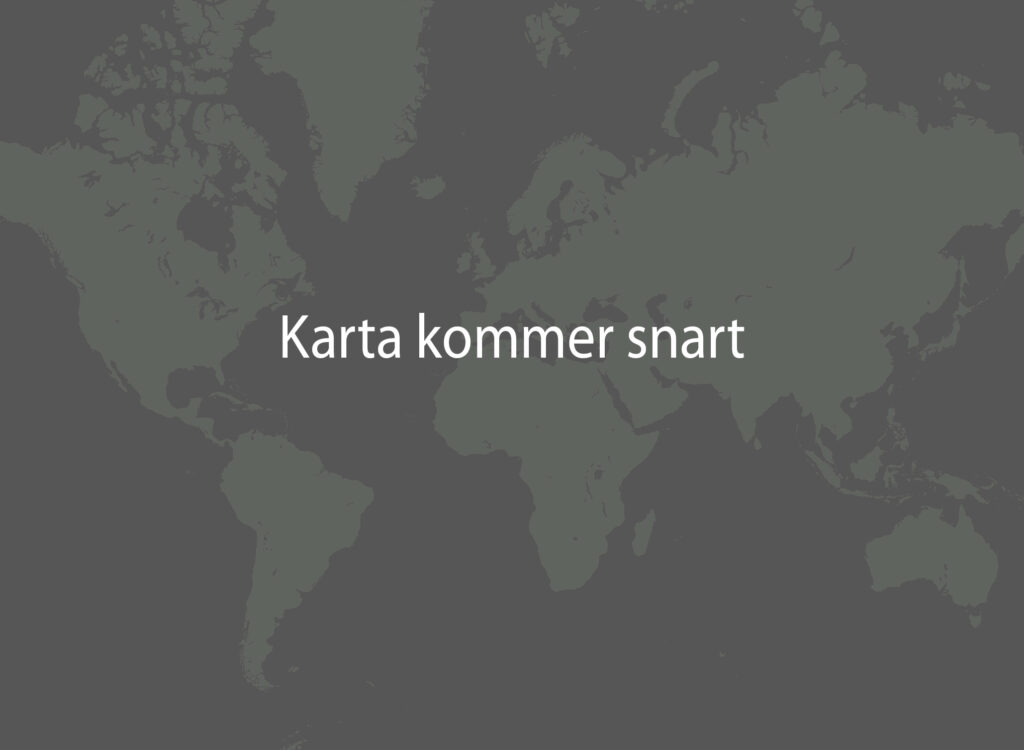Kris för de känsliga groddjuren
Groddjuren som även kallas för amfibier, minskar i antal runt om i världen. Detta brukar kallas för amfibiekrisen. Groddjuren som består av grodor, paddor, salamandrar och maskgroddjur andas delvis genom huden! Det gör att de lätt blir sjuka av till exempel miljögifter.
Mjölkgrodan lever i Amazonas regnskog, och ingår i gruppen amfibier.
Bild: Ellika-Nordström-Malmö-Museer
Paddorna ingår också i gruppen amfibier, som den här grönfläckiga paddan.
Bild: Frank-Vassen-CC-BY
Salamandrarna tillhör också amfibierna. Här syns en iransk bergssalamander.
Bild: Ellika-Nordström-Malmö-Museer
Maskgroddjuren är amfibiernas doldis. De liknar en stor daggmask eller en lite konstig orm, och lever främst i tropikerna. Här syns ett maskgroddjur som vaktar sina ägg.
Bild: Davidvraju-CC-BY-SA
Klimatförändringarna sprider sjukdomar
Det finns en parasitsvampsjukdom som drabbar groddjuren. Ökade temperaturer som kommit av klimatförändringarna, gör att svampsjukdomen tagit fart och nu sprids över hela jordklotet. Svampsjukdomen har utrotat en del amfibier helt, och många andra minskar kraftigt. I Amazonas har många arter drabbats mycket allvarligt. I Sverige har bland annat grönfläckig padda, strandpadda, gölgroda och klockgroda drabbats av svampsjukdomar.
I takt med klimatförändringarna ökar svampsjukdomar bland amfibierna.
Bild: Brian-Gratwicke-CC-BY
En groda som testas i laboratorium för att se om den är smittad av svamp.
Bild: CSIRO-CC-BY
Groddjuren är väldigt känsliga för miljögifter, som bekämpningsmedel i jordbruket.
Bild: Jeff-Vanuga-Public-Domain
Groddjuren behöver giftfria vatten för att kunna föröka sig.
Bild: Lynn-Betts-Public-Domain
Modernt jordbruk förgiftar grodornas vatten
Vi människor har påverkat och förändrat landskapet, runt om i hela världen. En stor påverkan är skogsskövling, och jordbruket är en annan. I jordbruk är det vanligt med något som kallas monokultur. Monokultur betyder att man bara odlar en gröda i taget, på jättestora ytor. I monokulturer används mycket gödsel, och man besprutar med gifter mot insekter och svampangrepp. Groddjuren behöver giftfria vattensamlingar för att leva och föröka sig. Grodor och paddor är dessutom väldigt känsliga för utsläpp av medicinrester via avlopp.

Bild: Grillo-CC-BY-SA
Alla kan hjälpa till
De nordiska länderna samarbetar för att föda upp och sätta ut hotade groddjur, och runt om i världen finns många forskare som försöker ta reda på hur vi kan rädda groddjuren. I Norden hjälper flera djurparker till med uppfödningen.
Men du kan också hjälpa till för att rädda groddjuren! Undvik att röra groddjur, och flytta aldrig grodor, paddor eller salamandrar mellan olika dammar. Om du besöker olika områden med dammar med groddjur så byt eller tvätta stövlar eller skor som du använt. Om du ser döda eller uppenbart sjuka groddjur, ring till Statens Veterinärmedicinska Anstalt (SVA) och anmäl det. Då hjälper du till att stoppa spridningen av svampsjukdomar.
Håll koll på vägen när du kör bil eller cyklar i områden där salamandrar, grodor och paddor rör sig. Flytta bort dem från vägbanan om du kan.
Engagera dig i en organisation som jobbar med att skydda groddjur. Det finns många både nationella och internationella projekt för att bevara groddjuren.

Mjölkgroda
Trachycephalus resinifictrix

Kommer aldrig ner på marken
Mjölkgrodan är en riktig akrobat. Deras stora, klibbiga tår klarar av att bära 14 gånger grodans egen kroppsvikt, och med hjälp av dem kan grodan svinga sig fram mellan trädgrenar och blad. Mjölkgrodan lever hela sitt liv uppe i träden. Det gör att den hotas av regnskogsskövling.

Bild: Ellika-Nordström-Malmö-Museer
Liknar fågelbajs
Mjölkgrodehonan lägger sina ägg i en vattensamling uppe i träden. Det kan vara i en liten hålighet i trädet eller mellan bladen på en växt. Redan ett dygn efter att äggen lagts kläcks det. Sedan tar det några veckor för grodynglen att utvecklas till små, färdiga grodor. Unga mjölkgrodor har större kontrast i färgerna än äldre, och det gör faktiskt deras kamouflage bättre. Vit kropp och mörka fläckar gör att grodorna liknar fågelspillning när de ligger på grenarna.
Giftig vätska
Sitt namn har mjölkgrodan fått från en mjölkvit vätska som den utsöndrar genom körtlar på ryggen om den blir rädd eller stressad. Vätskan är giftig och smakar illa, och gör därför att risken att mjölkgrodan äts upp minskar. Lokalt kallas mjölkgrodan ibland för ”sapo de canoeiro”. Det betyder ungefär ”kanotistgroda” och syftar på grodans läte. Deras högljudda kväkande låter ungefär som när en åra glider längs kanten på en kanot.
Utbredningsområde i världen

Amazonas regnskog.
Hotstatus enligt Rödlistan

Reglerad inom handel
CITES: Ej listad.

Vad är Rödlistan?
Rödlistning är ett sätt att bedöma om olika djur- och växtarter är utrotningshotade utifrån kriterier som hur många djur eller växter som finns av arten och hur utbredda de är. En nationell rödlistning bedömer artens risk att dö ut inom ett lands gränser. Den internationella rödlistningen bedömer artens risk att dö ut över hela jorden.
Läs mer

Om rödlistning i Sverige: Artdatabanken, www.artdatabanken.se
Om rödlistning i världen: International Union for Conservation of Nature, IUCN, www.iucn.org

Vad är CITES?
För att bekämpa olaglig handel med djur och växter finns en internationell överenskommelse om handel, som heter CITES. CITES innebär att utrotningshotade djur och växter inte får köpas eller säljas mellan olika länder utan tillstånd.
CITES klassar olika arter i olika kategorier (som kallas Appendix I, II och III) beroende på hur hotad arten är. Ju större hotet från handeln är desto högre skydd. Inom EU finns ytterligare skydd för arter i CITES. EU:s egen klassning har fyra steg: A-D.

Bild: Steve-Hillebrand
Förbjudet att handla med viltfångade arter
Högst skydd mot handel har de arter som är inom kategori A och B. Här gäller oftast att handel mellan EU och övriga världen är förbjuden utan tillstånd. Arter som är CITES A eller B-klassade får inte heller köpas eller säljas inom EU om det inte kan bevisas att de har lagligt ursprung och inte fångats i det vilda.
Att använda växter eller djur för att tillverka souvenirer och annat är också förbjudet. Den som bryter mot reglerna kan dömas till böter eller fängelse.
Kontrollera spridning av arter

Arter som är CITES C-klassade är utrotningshotade i ett visst land men inte nödvändigtvis i hela världen. CITES D-klassning betyder att en art importeras i så stort antal att de behöver regleras för att inte riskera att sprida sig okontrollerat där de inte hör hemma.

Crisis for the vulnerable amphibians
The world’s amphibian population is declining. It’s known as the amphibian crisis. Amphibians – frogs, toads and salamanders – are ectothermic. That means they adapt their temperature to that of their environment. Amphibians breathe partly through their skin! This makes them easily affected by such things as environmental pollutants.
The Amazon milk frog lives in the Amazon rainforest, and belongs to the group amphibians.
Photo: Ellika-Nordström-Malmö-Museums
Toads are also amphibians, like this European green toad.
Photo: Frank-Vassen-CC-BY
Salamanders are also amphibians, like this Luristan newt.
Photo: Ellika-Nordström-Malmö-Museums
Caecilians are the un-knowns of the amphibian group. They look like large earthworms or strange snakes, and live mostly in the tropics. The photo shows a caecilian guarding its eggs.
Photo: Davidvraju-CC-BY-SA
Climate change is causing the spread of diseases
There is a parasitic fungal disease that affects amphibians. Increased temperatures, brought on by climate change, has gained momentum and is now spreading all over the globe. The fungal disease has wiped out some amphibians completely, and is causing many others to decline sharply. In the Amazon, many species have been particularly severely affected. In Sweden, the European green toad, the natterjack toad, the pool frog and the European fire-bellied toad are among those affected by fungal diseases.
Fungal diseases are increasing among amphibians, in line with the climate change.
Photo: Brian-Gratwicke-CC-BY
A frog tested for fungal disease in a laboratory.
Photo: CSIRO-CC-BY
The amphibians are very sensitive to environmental toxins, such as agricultural pesticides.
Photo: Jeff-Vanuga-Public-Domain
The amphibians need water free of toxins in order to reproduce.
Photo: Lynn-Betts-Public-Domain
Modern agriculture pollutes the waters of frogs
All over the world, we humans have impacted and changed the landscape. Deforestation is one major impact, and agriculture is another. In agriculture, something called monoculture is common. Monoculture means growing only one crop at a time, on huge areas. Monocultures require intensive use of fertilisers, as well as the use of pesticides and fungicides against insects and fungi. Amphibians need unpolluted bodies of water in which to live and reproduce. Frogs and toads are also very sensitive to the release of pharmaceutical residues through wastewater.

Photo: Grillo-CC-BY-SA
Everyone can do something to help
The Nordic countries are working together to breed and release endangered amphibians, and many scientists around the world are trying to find out how we can save them. In the Nordic countries, several zoos are helping with breeding.
But you can also help to save the amphibians! Avoid touching amphibians, and never move frogs, toads or salamanders between ponds. If you visit different areas with amphibian ponds, change or wash the boots or shoes you have worn. If you see dead or visibly sick amphibians, call the National Veterinary Institute (SVA) and report it. This will help stop the spread of fungal diseases.
Keep an eye on the road when driving or cycling in areas where salamanders, frogs and toads roam. Move them off the road if you can.Get involved in an organisation that works to protect amphibians. There are many international projects to conserve amphibians, and the World Wide Fund for Nature (WWF) is one of the financial contributors to many of these projects.

Amazon Milk Frog
Trachycephalus resinifictrix

Never comes down to the ground
The Amazon milk frog is a real acrobat. Its large, sticky toes can carry 14 times the frog’s own weight and thanks to them, the frog can swing between branches and leaves. The Amazon milk frog spends its entire life in the trees – which means that the destruction of the rainforest is a serious threat to its survival.

Photo: Ellika-Nordström-Malmö-Museer
Looks like bird droppings
The female Amazon milk frog lays her eggs in a pool of water among the trees, e.g. in a tree cavity or at the centre of the overlapping leaf bases of bromeliads. The eggs hatch after only a day. It then takes a few weeks for the tadpoles to develop into small frogs. Young milk frogs have more contrast in their colouring than older frogs, which actually makes their camouflage better. A white body with dark spots makes the frogs look like bird droppings when they lie still on the branches.
Toxic fluid
The Amazon milk frog is named after the milky white fluid that it excretes through glands on its back when it becomes frightened or stressed. The fluid is toxic and tastes bad, and it reduces the risk of predators eating the frog. The frog is sometimes called “sapo de canoeiro” by locals in its native habitat. It means “canoeist frog” and refers to the sound that the frog emits. Its loud croaking is similar to the sound that an oar makes when it slides along the edge of a canoe.
Distribution worldwide

The Amazon rainforest.
Threat based on the Red List

Trade regulations
CITES: Not listed.

What is the Red List?
The Red List is a way to assess whether different animal and plant species are at risk of extinction based on criteria such as how many animals or plants of a species exist and how widely distributed they are. A national Red List assesses a species’ risk of dying out within national borders. The international Red List assesses a species’ risk of dying out worldwide.
Read more

About the Red List in Sweden: The Swedish Species Information Centre (Artdatabanken), www.artdatabanken.se/en/
About the Red List worldwide: The International Union for Conservation of Nature (IUCN), www.iucn.org

What is CITES?
CITES (the Convention on International Trade in Endangered Species of Wild Fauna and Flora) is a treaty that makes it illegal to buy or sell animals and plants that are at risk of extinction between countries without a permit.
CITES classifies species into different categories (called Appendix I, II and III) depending on how endangered each species is. In addition, the more the species is threatened by international trade, the higher its level of protection. Within the EU, CITES-listed species are further classified and protected by the EU’s own classification system. This has four Annexes, from A to D.

Photo: Steve-Hillebrand
Ban on trading wild-caught species
The highest protection against trade is given to CITES-listed species included in the EU’s Annexes A and B. Usually this means that trade between the EU and the rest of the world is illegal without a permit. There is also a ban on trading these species within the EU unless it can be proved that they have a lawful origin and were not caught in the wild.
It is also forbidden to use plants or animals to make souvenirs etc. Anyone who breaks these regulations can be fined or imprisoned.
Controlling the spread of species

CITES-listed species that are in the EU’s Annex C are classified as endangered in at least one country but not necessarily in the whole world. An Annex D classification means that individual members of a species may be imported to the extent that they do not need to be regulated to avoid any risk of them spreading uncontrollably where they do not belong.
